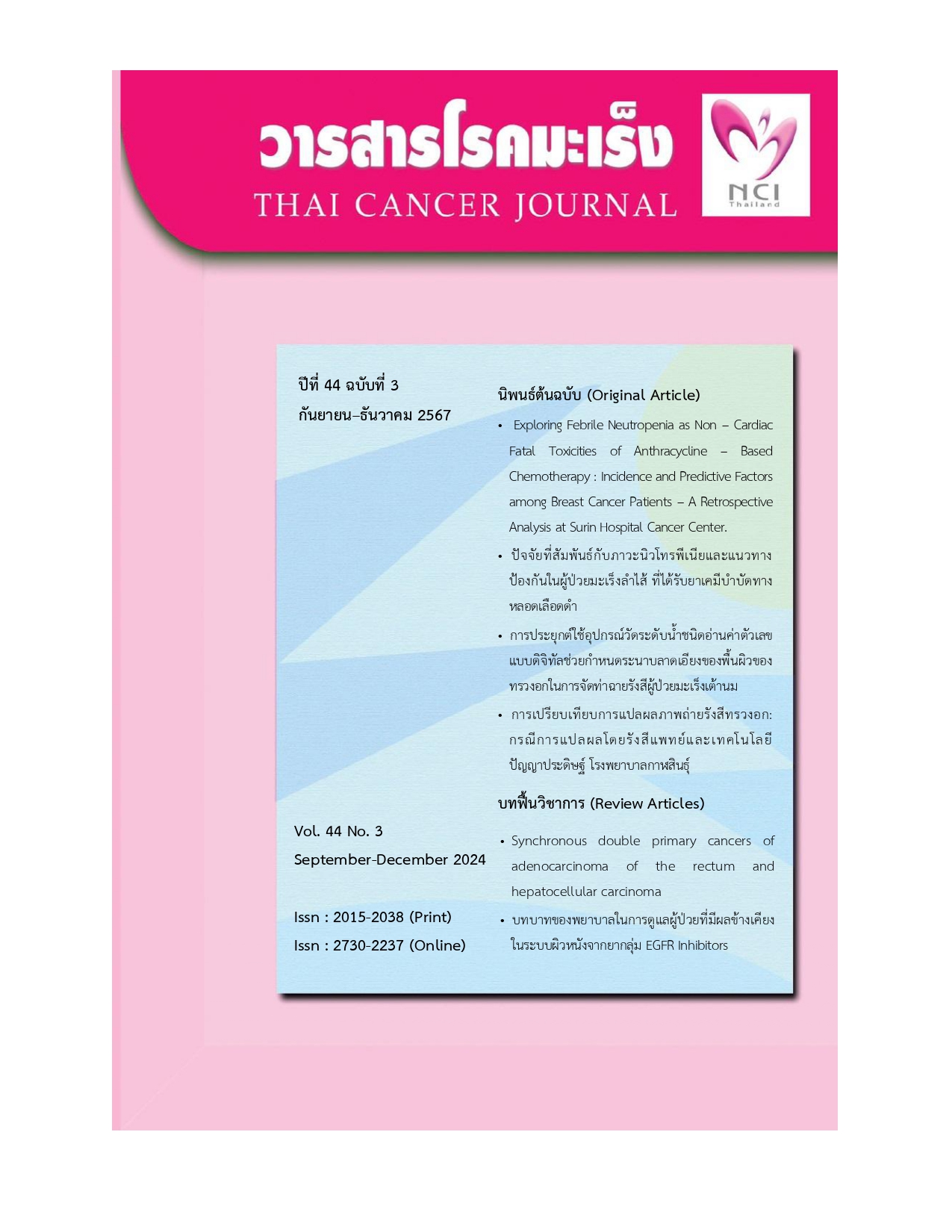Application of a Digital Spirit Water Level to Measure and Determine The Slope of The Chest Surface in Radiotherapy Positioning of Breast Cancer Patients.
Keywords:
Discrepancies in positioning radiation patients, Laser system, Water level measuring device that reads digital numbersAbstract
This research is to study the efficiency and accuracy of the application of using the laser system with the digital spirit water level (DSL) compared to using a laser system, which is a standard method. The study examined and assessed the errors, which could be caused by many factors, such as the use of fixation devices, the expertise of the radiotechnologist, and the patient. In the positioning of breast cancer patients before radiation therapy, using the Three Dimension Conformal Radiotherapy (3DCRT) techniques, Intensity Modulated Radiotherapy (IMRT) techniques, Volumetric Arc radiotherapy (VMAT) techniques. In ELEKTA InfinityTH and Accuray TomoH radiation machines of totaling 34 cases by selecting according to the inclusion and exclusion criteria, which assessed the error in 3 dimensions: left-right (X-axis), head-foot (Y-axis), and front-back (Z-axis) from X-rays in kV-kV-imaging mode and Cone Beam Computed Tomography (CBCT) mode. Compared with computed tomography simulation image. The results were the group of breast cancer patients who received pre-irradiation positioning using only the laser system had mean error in the X-axis, Y-axis, and Z-axis of -0.23±2.67 mm, -0.09±2.02 mm, and 3.09±2.84 mm, respectively. The groups using the laser and DSL systems had mean error in the X-axis, Y-axis, and Z-axis of -1.01±1.54 mm, -0.38±2.05 mm, and -0.26±1.68 mm, respectively. When analyzed by the independent t-tests to compare the mean error between the 2 systems, it was found that the mean in the X-axis and Y-axis was not significantly different (P=0.305 and P=0.689 respectively), while the mean in the Z-axis was significantly different (P=0.003). The study of the average time for patient positioning found that the positioning using the Laser system average of 40±21.87 minutes, while using the Laser system and DSL average of 7.94±6.13 minutes, which was statistically significantly different (P<0.001). In addition, the average number of repeated imaging sessions between the laser system and the laser system and DSL were compared and found to be 8.00±4.37 times and 1.58±1.23 times, respectively, which were statistically significantly different (P<0.001). The Total Vector Error (TVE) of the device using the laser system and the device using the Laser and DSL system were 3.12 and 1.11 mm, respectively. The average error of the planning target volume margin (PTV margin) in the X-axis, Y-axis, and Z-axis of the device using the laser system and the device using the Laser and DSL system were 11.34, 12.49, 17.48 and 8.85, 8.92, 7.56 mm, respectively. In summary, the comparison of the use of two systems, the standard laser system and the laser system combined with DSL, found that the positioning error values in breast cancer patients were not significantly different in the X-axis and Y-axis, except in the Z-axis. Therefore, the use of the laser system and DSL helped increase the accuracy of patient positioning, especially in the Z-axis, reduce the overall mean error (TVE), reduce the PTV margin error, and reduce the time for patient positioning, as well as reduce the number of re-imaging. There are resulting in patients not receiving unnecessary additional radiation doses according to the principles of safety and radiation hazard prevention.
References
Arnold M, Morgan E, Rumgay H, Mafra A, Singh D, Laversanne M, et al. Current and future burden of breast cancer: Global statistics for 2020 and 2040. Breast (Edinburgh, Scotland) 2022;66:15-23.
สถาบันมะเร็งแห่งชาติ กรมการแพทย์. Cancer in Thailand IX, 2016-2018. Bangkok. [Internet]. 2024 [cited 2024 Jun 27]. Available from: https://www.nci.go.th/e_book/cit_x/index.html
สถาบันมะเร็งแห่งชาติ กรมการแพทย์. ทะเบียนมะเร็งระดับโรงพยาบาล พ.ศ. 2563 (Hospital-based cancer registry 2020) [อินเทอร์เน็ต]. กรุงเทพฯ: กรมการแพทย์, สถาบันมะเร็งแห่งชาติ; 2565 [สืบค้นวันที่ 3 ส.ค. 2567]. เข้าถึงได้จาก: https://www.nci.go.th/e_book/hosbased_2563/index.html
สถาบันมะเร็งแห่งชาติ กรมการแพทย์. ทะเบียนมะเร็งระดับโรงพยาบาล พ.ศ. 2564 (Hospital-based cancer registry 2021) [อินเทอร์เน็ต]. กรุงเทพฯ: กรมการแพทย์, สถาบันมะเร็งแห่งชาติ; 2565 [สืบค้นวันที่ 2 ส.ค. 2567]. เข้าถึงได้จาก: https://www.nci.go.th/th/cancer_record/download/ HOSPITAL-BASED_2021.pdf
สถาบันมะเร็งแห่งชาติ กรมการแพทย์. ทะเบียนมะเร็งระดับโรงพยาบาล พ.ศ. 2565 (Hospital-based cancer registry 2022) [อินเทอร์เน็ต]. กรุงเทพฯ: กรมการแพทย์, สถาบันมะเร็งแห่งชาติ; 2565 [สืบค้นวันที่ 1 ส.ค. 2567]. เข้าถึงได้จาก:https://www.nci.go.th/th/cancer_record/download/ Hosbased-2022-1.pdf
McGale P, Taylor C, Correa C, Cutter D, Duane F, Ewertz M, et al. Effect of radiotherapy after mastectomy and axillary surgery on 10-year recurrence and 20-year breast cancer mortality: meta-analysis of individual patient data for 8135 women in 22 randomised trials. Lancet 2014;383:2127-35.
Darby S, McGale P, Correa C, Taylor C, Arriagada R, Clarke M, et al. Effect of radiotherapy after breastconserving surgery on 10-year recurrence and 15-year breast cancer death: meta-analysis of individual patient data for 10,801 women in 17 randomised trials. Lancet 2011;378:1707-16.
Verma V, Vicini F, Tendulkar RD, Khan AJ, Wobb J, Edwards-Bennett S, et al. Role of internal mammary node radiation as a part of modern breast cancer radiation therapy: a systematic review. Int J Radiat Oncol Biol Phys 2016;95:617-31.
บัญชา พันธุ์แตง, กนกพร ม่วงคำพร, ภัทราพร ฐาศศิร์, สกุลตลา รื่นจิตร, ปณิชา นวลสุธา, ทวีป แสงแห่งธรรม. การประเมินความคลาดเคลื่อนของการจัดท่าสำหรับการฉายรังสีรักษาในผู้ป่วยมะเร็งเต้านมโดยใช้ระบบภาพผิวแบบสามมิติ. J Thai Assoc Radiat Oncol 2020;26:R68-R75.
Van Herk M. Errors and margins in radiotherapy. Semin Radiat Oncol 2004;14:52-64
Chung MJ, Lee GJ, Suh YJ, Lee HC, Lee S-W, Jeong S, et al. Setup error and effectiveness of weekly image-guided radiation therapy of TomoDirect for early breast cancer. Cancer Res Treat Off J Korean Cancer Assoc 2015;47:774-80.
Downloads
Published
Issue
Section
License

This work is licensed under a Creative Commons Attribution-NonCommercial-NoDerivatives 4.0 International License.
บทความทีตีพิมพ์ในวารสารโรคมะเร็งนี้ถือว่าเป็นลิขสิทธิ์ของมูลนิธิสถาบันมะเร็งแห่งชาติ และผลงานวิชาการหรือวิจัยของคณะผู้เขียน ไม่ใช่ความคิดเห็นของบรรณาธิการหรือผู้จัดทํา






